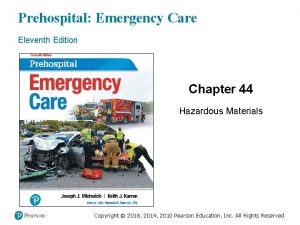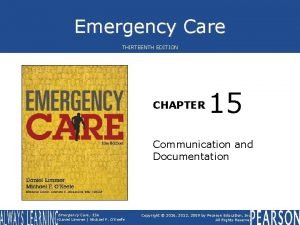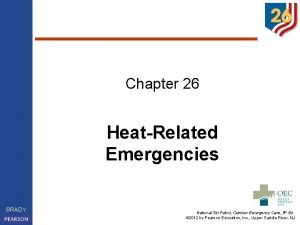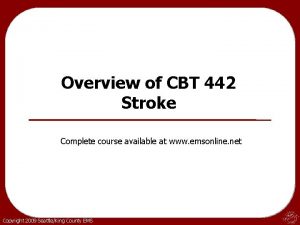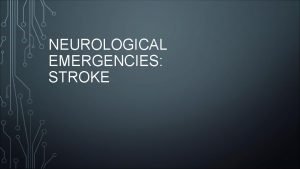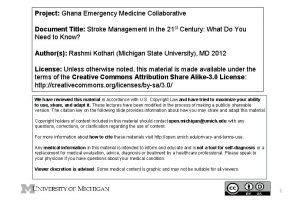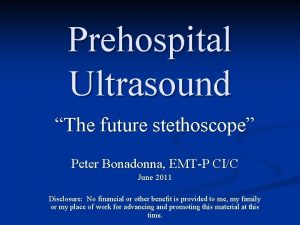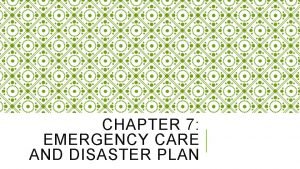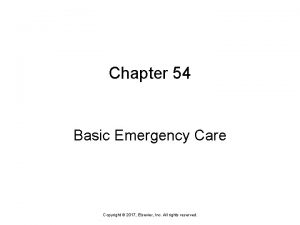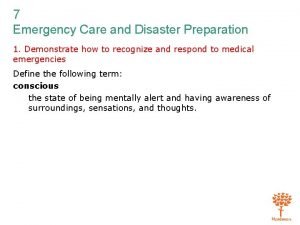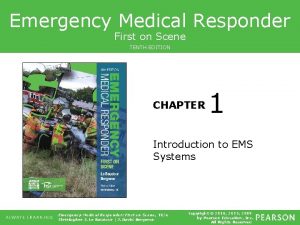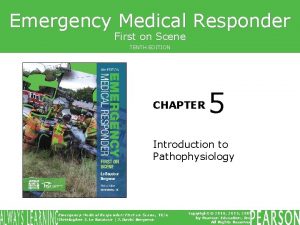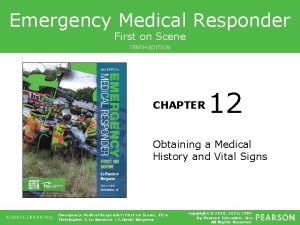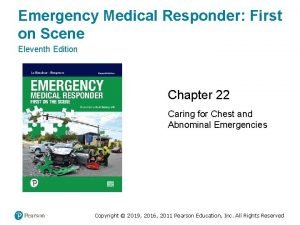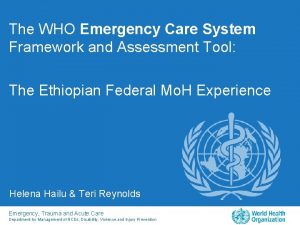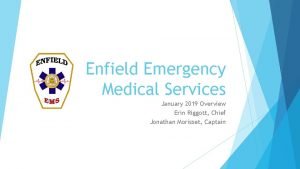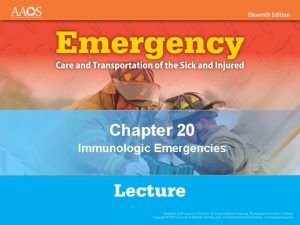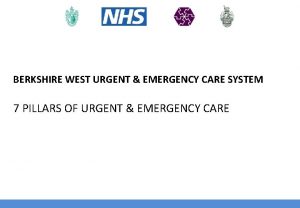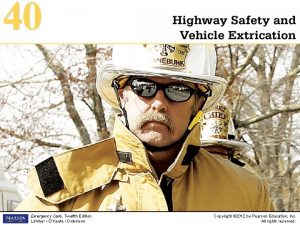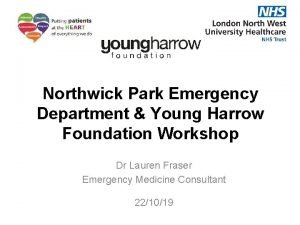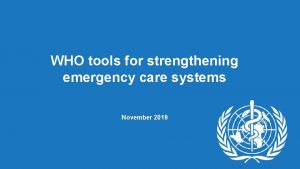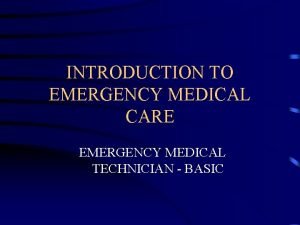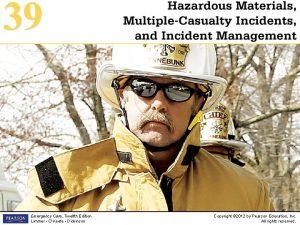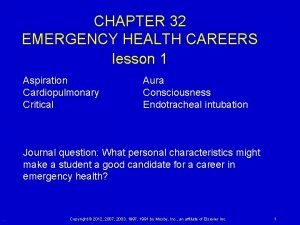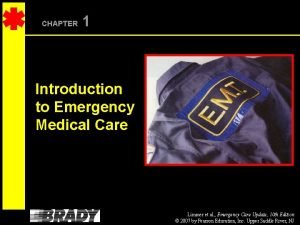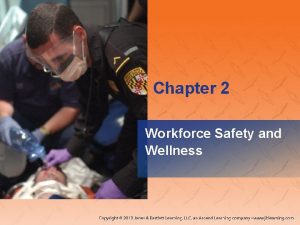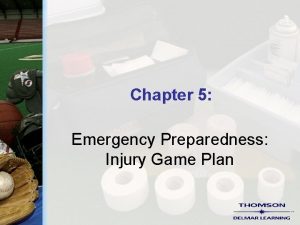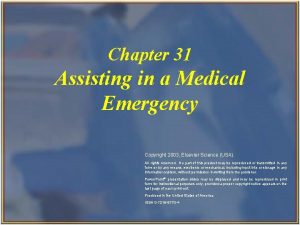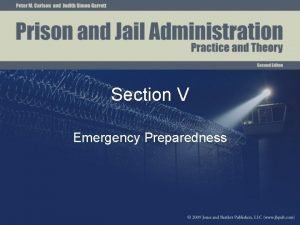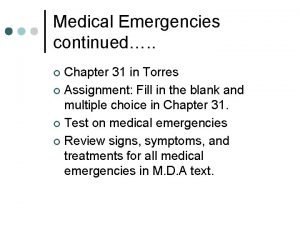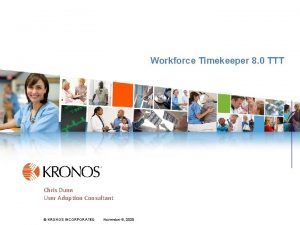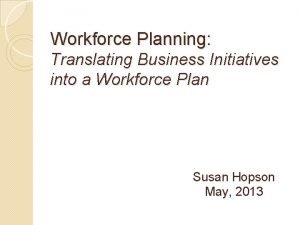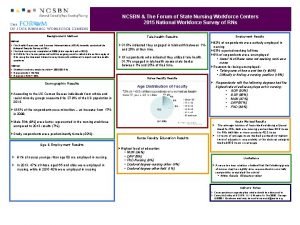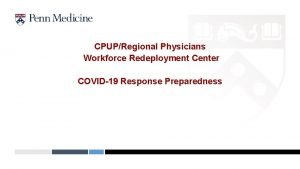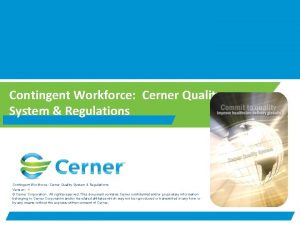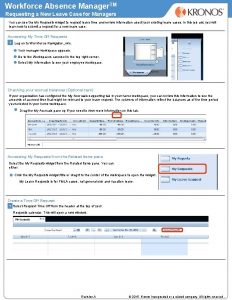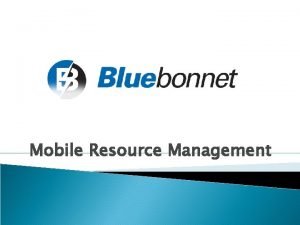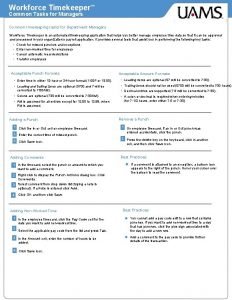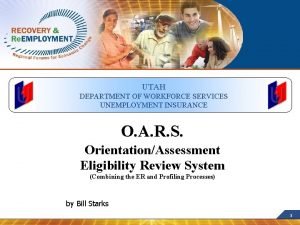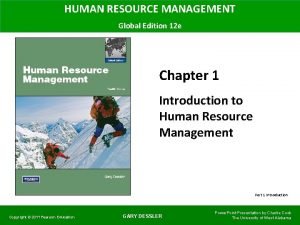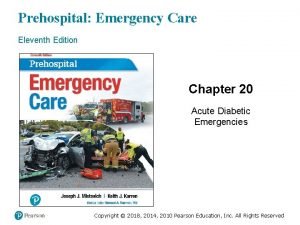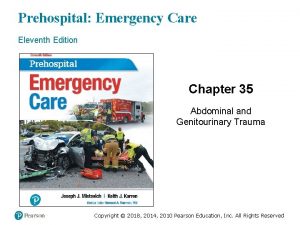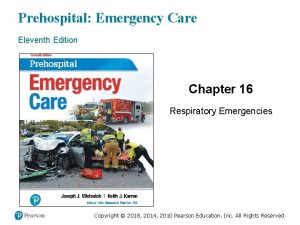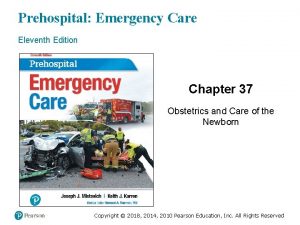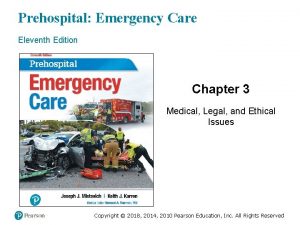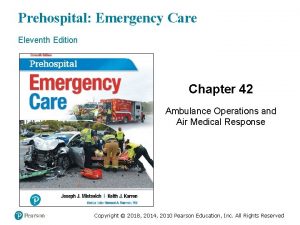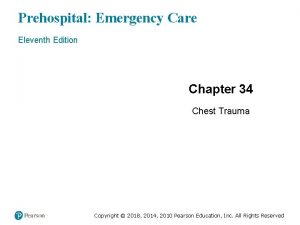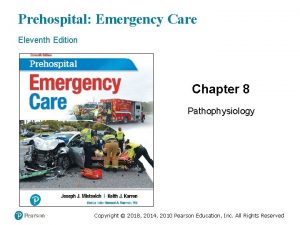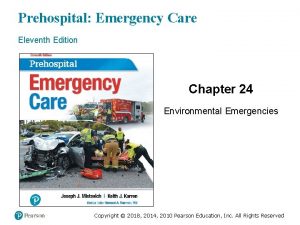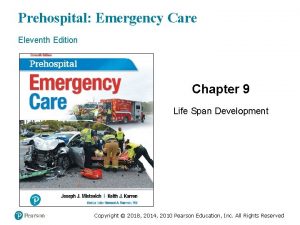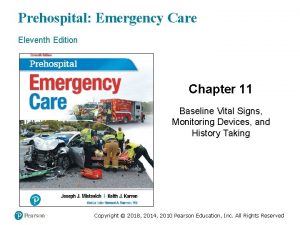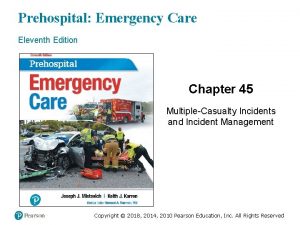Prehospital Emergency Care Eleventh Edition Chapter 2 Workforce








































































































- Slides: 104

Prehospital: Emergency Care Eleventh Edition Chapter 2 Workforce Safety and Wellness of the EMT Slides in this presentation contain hyperlinks. JAWS users should be able to get a list of links by using INSERT+F 7 Copyright © 2018, 2014, 2010 Pearson Education, Inc. All Rights Reserved

Learning Readiness • EMS Education Standards, text p 19. age • Chapter Objectives, text p 19. age • Key Terms, text p 19. age • Purpose of lecture presentation versus textbook reading assignments. Copyright © 2018, 2014, 2010 Pearson Education, Inc. All Rights Reserved

Setting the Stage • Overview of Lesson Topics – Emotional aspects of emergency care – Scene safety – Wellness principles Copyright © 2018, 2014, 2010 Pearson Education, Inc. All Rights Reserved

Case Study Introduction EMTs Connor Fleisher and Melinda Jurgens are approaching unit 121 at Ashford Springs, an assisted living facility, where they were dispatched for a report of a sick person. Copyright © 2018, 2014, 2010 Pearson Education, Inc. All Rights Reserved

Case Study (1 of 11) • Are there particular issues that should be anticipated when responding to an assisted living facility? • What hazards should the EMTs be looking for in this situation? • What actions should they consider in anticipation of potential hazards? Copyright © 2018, 2014, 2010 Pearson Education, Inc. All Rights Reserved

Introduction • EMS providers’ safety is the first priority on every call. • EMTs must be prepared to deal with emotions of patients and their family members. • EMTs must be concerned with their own physical and emotional wellness. Copyright © 2018, 2014, 2010 Pearson Education, Inc. All Rights Reserved

Emotional Aspects of Emergency Care (1 of 12) • Death and dying – Inherent parts of emergency medicine • Five emotional stages: – Denial – Anger – Bargaining – Depression – Acceptance Copyright © 2018, 2014, 2010 Pearson Education, Inc. All Rights Reserved

Review Questions (1 of 5) • Click the statement on the right that represents the thought process of a person in the stage of grief below: Denial “Oh please, if you just let my husband be ok, I’ll be a better person. ” “No! I can’t believe this. This can’t be happening!” “This is the doctor’s fault. He should have tested me sooner. I am going to sue him!” “I can’t go through this. I can’t get up every day knowing I only have a few months to live. ” “I know my wife is gone, but life goes on, and I will honor her memory in my actions. ” Copyright © 2018, 2014, 2010 Pearson Education, Inc. All Rights Reserved

Review Questions (2 of 5) • Click the statement on the right that represents the thought process of a person in the stage of grief below: Anger “Oh please, if you just let my husband be ok, I’ll be a better person. ” “This is the doctor’s fault. He should have tested me sooner. I am going to sue him!” “No! I can’t believe this. This can’t be happening!” “I can’t go through this. I can’t get up every day knowing I only have a few months to live. ” “I know my wife is gone, but life goes on, and I will honor her memory in my actions. ” Copyright © 2018, 2014, 2010 Pearson Education, Inc. All Rights Reserved

Review Questions (3 of 5) • Click the statement on the right that represents the thought process of a person in the stage of grief below: Bargaining “I know my wife is gone, but life goes on, and I will honor her memory in my actions. ” “No! I can’t believe this. This can’t be happening!” “This is the doctor’s fault. He should have tested me sooner. I am going to sue him!” “I can’t go through this. I can’t get up every day knowing I only have a few months to live. ” “Oh please, if you just let my husband be ok, I’ll be a better person. ” Copyright © 2018, 2014, 2010 Pearson Education, Inc. All Rights Reserved

Review Questions (4 of 5) • Click the statement on the right that represents the thought process of a person in the stage of grief below: Depression “Oh please, if you just let my husband be ok, I’ll be a better person. ” “No! I can’t believe this. This can’t be happening!” “This is the doctor’s fault. He should have tested me sooner. I am going to sue him!” “I can’t go through this. I can’t get up every day knowing I only have a few months to live. ” “I know my wife is gone, but life goes on, and I will honor her memory in my actions. ” Copyright © 2018, 2014, 2010 Pearson Education, Inc. All Rights Reserved

Review Questions (5 of 5) • Click the statement on the right that represents the thought process of a person in the stage of grief below: “Oh please, if you just let my husband be ok, I’ll be a better person. ” “No! I can’t believe this. This can’t be happening!” “This is the doctor’s fault. He should have tested me sooner. I am going to sue him!” Acceptance “I know my wife is gone, but life goes on, and I will honor her memory in my actions. ” “I can’t go through this. I can’t get up every day knowing I only have a few months to live. ” Copyright © 2018, 2014, 2010 Pearson Education, Inc. All Rights Reserved

Emotional Aspects of Emergency Care (2 of 12) • Dealing with the dying patient, their family members, and bystanders – EMT has obligation to help the patients and others. – Each individual may be in their own respective stage. – Textbook lists several ways to reduce their emotional burden (p 21). age Copyright © 2018, 2014, 2010 Pearson Education, Inc. All Rights Reserved

Case Study (2 of 11) Connor and Melinda are met at the door by a young woman who has been crying. The woman says, “It’s my grandfather. His name is James Bennett. He has heart failure and kidney failure, but he is a lot worse today. My mom called and said he has a high fever and is disoriented. ” Copyright © 2018, 2014, 2010 Pearson Education, Inc. All Rights Reserved

Case Study (3 of 11) • How should Connor and Melinda interact with Mr. Bennett? • What can they say or do to help comfort his family? • What is the significance of knowing the patient has a fever? Copyright © 2018, 2014, 2010 Pearson Education, Inc. All Rights Reserved

Emotional Aspects of Emergency Care (3 of 12) • High stress situations and stressors related to the profession – Long hours – Boredom between calls – Working too much, too hard – Getting little recognition – Having to respond instantly Copyright © 2018, 2014, 2010 Pearson Education, Inc. All Rights Reserved

Emotional Aspects of Emergency Care (4 of 12) • High stress situations and stressors related to patient care – Making life-and-death decisions, fearing serious errors – Being responsible for someone’s life – Abuse and neglect of pediatrics and geriatrics – Caring for infants and children – Mass casualty incidents – Injury or death of a coworker Copyright © 2018, 2014, 2010 Pearson Education, Inc. All Rights Reserved

Emotional Aspects of Emergency Care (5 of 12) • Stress Reactions – EMTs may suffer three types of stress reactions: ▪ Acute stress reaction ▪ Delayed stress reaction ▪ Cumulative stress reaction (i. e. burnout) Copyright © 2018, 2014, 2010 Pearson Education, Inc. All Rights Reserved

Emotional Aspects of Emergency Care (6 of 12) • Stress Reactions – General categories of stress findings ▪ Thinking ▪ Psychological ▪ Physical ▪ Behavioral ▪ Social Copyright © 2018, 2014, 2010 Pearson Education, Inc. All Rights Reserved

Emotional Aspects of Emergency Care (7 of 12) • Stress Management – Making lifestyle changes by the EMT ▪ Avoid self medication ▪ Exercise often Copyright © 2018, 2014, 2010 Pearson Education, Inc. All Rights Reserved

Emotional Aspects of Emergency Care (8 of 12) • Stress Management – Making lifestyle changes by the EMT ▪ Diet considerations ▪ Learn to relax – Take measures to maintain balance in your life Copyright © 2018, 2014, 2010 Pearson Education, Inc. All Rights Reserved

Emotional Aspects of Emergency Care (9 of 12) • Stress Management – Recognize the responses of family and friends: ▪ Lack of understanding ▪ Fear of separation ▪ Inability to plan ▪ Frustrated desire to share Copyright © 2018, 2014, 2010 Pearson Education, Inc. All Rights Reserved

Emotional Aspects of Emergency Care (10 of 12) • Stress Management – Make changes in your work environment. ▪ Develop a buddy system with a coworker. ▪ Encourage and support coworkers, resist the temptation to dwell on the negative. ▪ Take a break to exercise. ▪ Request shifts that allow more relaxation. ▪ Seek professional help if necessary. Copyright © 2018, 2014, 2010 Pearson Education, Inc. All Rights Reserved

Emotional Aspects of Emergency Care (11 of 12) • Critical Incident Stress Management – Symptoms of burnout may occur after exposure to a critical incident. – Sufferers of critical incident stress also may have repeated mental images of the situation, inability to function on subsequent calls, and fear of continuing work in EMS. Copyright © 2018, 2014, 2010 Pearson Education, Inc. All Rights Reserved

Emotional Aspects of Emergency Care (12 of 12) • The critical incident stress management (CISM) process consists of two approaches: – Critical incident stress debriefing (CISD) – Critical incident stress defusing Copyright © 2018, 2014, 2010 Pearson Education, Inc. All Rights Reserved

Case Study (4 of 11) Connor assures the family that he and Melinda are there to help and that they will let the family know what their findings are. The EMTs pull on disposable exam gloves as they ask about symptoms that may be related to infectious diseases against which they should take additional precautions. Copyright © 2018, 2014, 2010 Pearson Education, Inc. All Rights Reserved

Case Study (5 of 11) • What signs and symptoms may indicate that the patient has a communicable illness? • What factors should the EMTs take into considerations in deciding whether it is necessary to use Standard Precautions other than gloves? • As they approach the patient, are there other safety considerations? Copyright © 2018, 2014, 2010 Pearson Education, Inc. All Rights Reserved

Scene Safety (1 of 35) • What is scene safety? – Taking appropriate measures to protect yourself from infectious diseases – Following proper rescue procedures – Handling violence properly – Being an advocate for safety Copyright © 2018, 2014, 2010 Pearson Education, Inc. All Rights Reserved

Scene Safety (2 of 35) • Protecting Yourself from Disease – Infectious diseases are caused by pathogens, which include: ▪ Bacteria ▪ Viruses ▪ Fungi ▪ Protozoa ▪ Helminths Copyright © 2018, 2014, 2010 Pearson Education, Inc. All Rights Reserved

Scene Safety (3 of 35) • Types of Pathogens – Bacteria ▪ Single-celled organisms that can reproduce ▪ Usually respond to antibiotic therapy (when needed) Copyright © 2018, 2014, 2010 Pearson Education, Inc. All Rights Reserved

Scene Safety (4 of 35) • Types of Pathogens – Viruses ▪ Require a host to reproduce ▪ Invade cells in order to reproduce new viral particles ▪ Not responsive to antibiotics; there are few medications to treat viral infections ▪ Most cause mild, self-limiting illnesses Copyright © 2018, 2014, 2010 Pearson Education, Inc. All Rights Reserved

Scene Safety (5 of 35) • Types of Pathogens – Fungi ▪ Plant-like microorganisms ▪ Usually do not cause illness when the immune system is functioning normally ▪ Can be a problem in patients with immune deficiency Copyright © 2018, 2014, 2010 Pearson Education, Inc. All Rights Reserved

Scene Safety (6 of 35) • Types of Pathogens – Protozoa ▪ Single-celled organisms capable of movement ▪ Often found in the soil ▪ Illnesses include: – Some forms of gastroenteritis – Some vaginal infections – Malaria Copyright © 2018, 2014, 2010 Pearson Education, Inc. All Rights Reserved

Scene Safety (7 of 35) • Types of Pathogens – Helminths (parasitic worms) ▪ Examples include: – Roundworms – Flukes – Tapeworms – Hookworms Copyright © 2018, 2014, 2010 Pearson Education, Inc. All Rights Reserved

Scene Safety (8 of 35) • Protecting Yourself from Disease – Infectious disease are contracted from pathogens. – Some infectious diseases can be passed from person to person, and are called communicable diseases. – Diseases can be spread directly or indirectly. Copyright © 2018, 2014, 2010 Pearson Education, Inc. All Rights Reserved

An Open Sore on the Arm of an Apparent Drug User is an Example of an Open Wound that has the Potential to Spread Infection Copyright © 2018, 2014, 2010 Pearson Education, Inc. All Rights Reserved

Scene Safety (9 of 35) • Protecting Yourself from Disease – Standard Precautions ▪ Guidelines developed by OSHA to protect health care workers from communicable disease. ▪ Employers must ensure that the Standard Precautions are available, and must have a written exposure control plan. Copyright © 2018, 2014, 2010 Pearson Education, Inc. All Rights Reserved

Scene Safety (10 of 35) • Protecting Yourself from Disease – Standard Precautions ▪ Hand washing 1. 2. 3. 4. 5. Wet Lather Scrub Rinse Dry Copyright © 2018, 2014, 2010 Pearson Education, Inc. All Rights Reserved

Scene Safety (11 of 35) • Protecting Yourself from Disease – Alcohol-based hand sanitizer can be used when you do not have access to soap and water. ▪ Use a product with at least 60 percent alcohol. ▪ As soon as possible, wash with soap and water. Copyright © 2018, 2014, 2010 Pearson Education, Inc. All Rights Reserved

Scene Safety (12 of 35) • Protecting Yourself from Disease – Personal protective equipment (PPE) ▪ Eye protection Copyright © 2018, 2014, 2010 Pearson Education, Inc. All Rights Reserved

Scene Safety (13 of 35) • Protecting Yourself from Disease – Personal protective equipment (PPE) ▪ Protective gloves Copyright © 2018, 2014, 2010 Pearson Education, Inc. All Rights Reserved

Scene Safety (14 of 35) • Protecting Yourself from Disease – Personal protective equipment (PPE) ▪ Gowns ▪ Masks Copyright © 2018, 2014, 2010 Pearson Education, Inc. All Rights Reserved

Scene Safety (15 of 35) • Protecting Yourself from Disease – Personal protective equipment (PPE) ▪ HEPA respirator ▪ N-95 respirator Copyright © 2018, 2014, 2010 Pearson Education, Inc. All Rights Reserved

EMT Skills 2 -1 Safe Glove Removal Copyright © 2018, 2014, 2010 Pearson Education, Inc. All Rights Reserved

Follow a Safe Technique for Removal of Gloves Use only contaminated glove surfaces to touch other contaminated glove surfaces, and use clean inside glove surfaces to touch other clean inside glove surfaces. Do not touch a contaminated surface with your bare hand or fingers. Copyright © 2018, 2014, 2010 Pearson Education, Inc. All Rights Reserved

Use a Gloved Finger to Pull a Cuff out and Down on the Other Glove Do not touch the inside of the glove. Copyright © 2018, 2014, 2010 Pearson Education, Inc. All Rights Reserved

Without Touching the Inside of the Glove, Continue Pulling it Downward Copyright © 2018, 2014, 2010 Pearson Education, Inc. All Rights Reserved

Crumple the Contaminated Glove in the Hand Still Wearing a Contaminated Glove and Discard it in a Biohazard Receptacle Ensuring that it does not touch any clean surfaces. Copyright © 2018, 2014, 2010 Pearson Education, Inc. All Rights Reserved

Begin to Remove the Other Glove by Inserting Clean, Uncontaminated Fingers into the Uncontaminated Inside of the Remaining Glove Cuff Copyright © 2018, 2014, 2010 Pearson Education, Inc. All Rights Reserved

Continue to Roll the Glove off Your Hand, Being Sure Your Clean Hand Touches Only the Clean Inside Surfaces of the Second Glove Copyright © 2018, 2014, 2010 Pearson Education, Inc. All Rights Reserved

Drop the Glove into the Biohazard Receptacle Being careful that the contaminated glove does not touch your clean hands nor any other clean surface Copyright © 2018, 2014, 2010 Pearson Education, Inc. All Rights Reserved

Scene Safety (16 of 35) • Protecting Yourself from Disease – Additional guidelines ▪ Use disposable equipment. ▪ Wash soiled clothing/uniforms. ▪ Document any exposures. ▪ Bag infectious items. Copyright © 2018, 2014, 2010 Pearson Education, Inc. All Rights Reserved

Scene Safety (17 of 35) • Protecting Yourself from Disease – Additional guidelines ▪ Use sharps containers. ▪ Clean up blood/body fluids. ▪ Clean visible soil from nonhorizontal walls. ▪ Always wash hands thoroughly. Copyright © 2018, 2014, 2010 Pearson Education, Inc. All Rights Reserved

Scene Safety (18 of 35) • Protecting Yourself from Disease – Additional guidelines ▪ Cleaning ▪ Disinfecting ▪ Sterilization Copyright © 2018, 2014, 2010 Pearson Education, Inc. All Rights Reserved

Scene Safety (19 of 35) • Protecting Yourself from Disease – Immunizations – Influenza (annually) – Tetanus (every 10 years) – Hepatitis B – Polio – Rubella – Measles – Mumps – Varicella (chickenpox) Copyright © 2018, 2014, 2010 Pearson Education, Inc. All Rights Reserved

Scene Safety (20 of 35) • Protecting Yourself from Disease – Reporting exposures ▪ Report exposures following state and local laws and your employer’s policies. ▪ Report the exposure as soon as possible to your supervisor, including the date, time, and details of the exposure. Copyright © 2018, 2014, 2010 Pearson Education, Inc. All Rights Reserved

Scene Safety (21 of 35) Copyright © 2018, 2014, 2010 Pearson Education, Inc. All Rights Reserved

Scene Safety (22 of 35) • Infectious Diseases of Concern – Hepatitis ▪ Hepatitis B and hepatitis C are viral infections of the liver. ▪ Contracted through contact with blood and body fluids. ▪ Infected persons can be asymptomatic, but still transmit the disease. Copyright © 2018, 2014, 2010 Pearson Education, Inc. All Rights Reserved

Scene Safety (23 of 35) • Infectious Diseases of Concern – Tuberculosis ▪ Most often tuberculosis affects the lungs, but it can affect other tissues. ▪ Spreads by breathing in the infected droplets of sputum of a the patient with a cough. ▪ There antibiotic-resistant forms. Copyright © 2018, 2014, 2010 Pearson Education, Inc. All Rights Reserved

Scene Safety (24 of 35) • Infectious Diseases of Concern – Acquired immune deficiency syndrome (AIDS) ▪ Results from infection with the human immunodeficiency virus (HIV) ▪ More difficult than hepatitis B to transmit through occupational exposure ▪ Impairs the body’s ability to fight infections Copyright © 2018, 2014, 2010 Pearson Education, Inc. All Rights Reserved

Scene Safety (25 of 35) • Infectious Diseases of Concern – Severe acute respiratory syndrome (SARS) ▪ Spread by person-to-person respiratory contact ▪ Accompanied by high fever, headache, body aches Copyright © 2018, 2014, 2010 Pearson Education, Inc. All Rights Reserved

Scene Safety (26 of 35) • Infectious Diseases of Concern – West Nile virus ▪ Mosquito-borne ▪ Most infected patients have no symptoms or mild symptoms ▪ A few patients develop severe symptoms that can last for weeks Copyright © 2018, 2014, 2010 Pearson Education, Inc. All Rights Reserved

Scene Safety (27 of 35) • Infectious Diseases of Concern – Ebola ▪ Viral hemorrhagic fever ▪ Normally found on African continent ▪ Marburg, Lassa, Yellow fever, and Ebola Copyright © 2018, 2014, 2010 Pearson Education, Inc. All Rights Reserved

Scene Safety (28 of 35) • Infectious Diseases of Concern – Zika virus disease ▪ Spread by mosquitos ▪ Rarely fatal, but can cause birth defects to unborn child of infected mother ▪ No vaccination exists ▪ Avoidance and prevention are key to limiting infection Copyright © 2018, 2014, 2010 Pearson Education, Inc. All Rights Reserved

Scene Safety (29 of 35) • Infectious Diseases of Concern – Multidrug-resistant organisms ▪ Common to patients who frequent the health care system. ▪ May cause pneumonia; infections of the blood, ear, sinuses, and skin; peritonitis. ▪ Follow Standard Precautions, and any additional instructions provided by the medical facility. Copyright © 2018, 2014, 2010 Pearson Education, Inc. All Rights Reserved

Table 2 -1 Infectious Diseases, Transmission, and Personal Protective Measures (1 of 3) Disease Transmission Mode Incubation Period Protective Measures HIV/AIDS Blood, semen, vaginal fluid, blood transfusion, needlestick, transplacental Months Gloves, eyewear, hand washing Hepatitis B and C Blood, semen, vaginal fluid, needlestick, transplacental, human bite, sexual contact (HBV) Weeks or months Gloves, eyewear, hand washing Tuberculosis Respiratory secretions, airborne or direct contact 2– 6 weeks Gloves, eyewear, HEPA or N-95 respirator, hand washing Influenza Airborne droplets, direct contact with body fluids 1– 3 days Gloves, surgical mask, hand washing Chicken pox (varicella) Airborne droplets, direct contact with open sores 11– 21 days Gloves, surgical mask, hand washing Copyright © 2018, 2014, 2010 Pearson Education, Inc. All Rights Reserved

Table 2 -1 Infectious Diseases, Transmission, and Personal Protective Measures (2 of 3) Disease Transmission Mode Incubation Period Protective Measures Bacterial meningitis Oral and nasal secretions 2– 10 days Gloves, surgical mask, hand washing Pneumonia Respiratory secretions and droplets 1– 3 days Gloves, surgical mask, hand washing German measles (rubella) Airborne droplets, transplacental 10– 12 days Gloves, surgical mask, hand washing Whooping cough (pertussis) Respiratory secretions, airborne droplets 6– 20 days Gloves, surgical mask, hand washing Staphylococcal skin infection Direct contact with infected lesion or contaminated object 1– 3 days Gloves, hand washing Copyright © 2018, 2014, 2010 Pearson Education, Inc. All Rights Reserved

Table 2 -1 Infectious Diseases, Transmission, and Personal Protective Measures (3 of 3) Disease Transmission Mode Incubation Period Protective Measures Severe acute respiratory syndrome (SARS) coronavirus Respiratory airborne, direct contact 10 days Gloves, surgical mask, hand washing, eye protection Ebola virus disease (EVD) Direct contact with blood or contact with body fluids 2– 21 days (average onset of 8– 10 days) Gloves, hand washing, N-95 respirator, surgical/isolation gown, boot covers, specialized training in donning/doffing PPE Zika virus disease (ZVD) Bite of an infected Aedes mosquito, from pregnant woman to fetus, sexual contact with an infected person 3– 12 days Avoiding mosquito bites, abstaining from sex with an infected or potentially infected partner (using condoms during sexual intercourse reduces the risk), preventing pregnancy. avoiding mosquito exposure in areas where ZVD is known to occur Copyright © 2018, 2014, 2010 Pearson Education, Inc. All Rights Reserved

Case Study (6 of 11) Mr. Bennett has not had a cough, but has a history of urinary tract infections that have led to similar signs and symptoms. Mr. Bennett’s confusion is accompanied by some agitation, so Connor and Melinda speak calmly to him, but maintain alertness to the possibility that the agitation could lead to physical combativeness. Copyright © 2018, 2014, 2010 Pearson Education, Inc. All Rights Reserved

Case Study (7 of 11) • In addition to gloves, what PPE, if any, is needed? Copyright © 2018, 2014, 2010 Pearson Education, Inc. All Rights Reserved

Scene Safety (30 of 35) • Protecting Yourself from Injury – Prevention strategies include: ▪ Use of vehicle restraint systems ▪ Safe lifting and moving techniques ▪ Getting adequate sleep ▪ Physical fitness and proper nutrition ▪ Using Standard Precautions Copyright © 2018, 2014, 2010 Pearson Education, Inc. All Rights Reserved

Scene Safety (31 of 35) • Protecting Yourself from Injury – Other actions to protect yourself must be taken in the following situations: ▪ Rescue operations ▪ Hazardous materials incidents ▪ Violence/crime scenes ▪ Biological and chemical weapons of mass destruction Copyright © 2018, 2014, 2010 Pearson Education, Inc. All Rights Reserved

Scene Safety (32 of 35) • Protecting Yourself from Injury – Other actions to protect yourself must be taken in the following situations: ▪ Hazardous materials – Use binoculars and the U. S. DOT Emergency Response Guidebook. – Request a hazardous materials team. – Allow hazardous materials personnel to decontaminate patients and bring them to you. Copyright © 2018, 2014, 2010 Pearson Education, Inc. All Rights Reserved

Examples of Hazardous Materials Warning Placards Copyright © 2018, 2014, 2010 Pearson Education, Inc. All Rights Reserved

The Emergency Response Guidebook Should be Carried on all EMS Vehicles Copyright © 2018, 2014, 2010 Pearson Education, Inc. All Rights Reserved

Self-Contained Breathing Apparatus (SCBA) Copyright © 2018, 2014, 2010 Pearson Education, Inc. All Rights Reserved

Typical Hazardous Materials Protective Suits (a) Being Donned (b) In Use Copyright © 2018, 2014, 2010 Pearson Education, Inc. All Rights Reserved

Scene Safety (33 of 35) • Protecting Yourself from Injury – Rescue situations ▪ Hazards may include, but are not limited to: – Downed power lines – Fire or threat of fire – Explosion or threat of explosion – Hazardous materials – Low oxygen environments Copyright © 2018, 2014, 2010 Pearson Education, Inc. All Rights Reserved

Downed Power Lines Pose a Potential Life Threat for Patients and Rescuers Copyright © 2018, 2014, 2010 Pearson Education, Inc. All Rights Reserved

Downed Wires are Dangerous Even if no Fire or Sparks are Evident Copyright © 2018, 2014, 2010 Pearson Education, Inc. All Rights Reserved

Scene Safety (34 of 35) • Protecting Yourself from Injury – Federal law requires use of high visibility apparel at/near roadways – High visibility vest/garments ▪ Class 1 ▪ Class 2 ▪ Class 3 Copyright © 2018, 2014, 2010 Pearson Education, Inc. All Rights Reserved

Use of ANSI/ISEA 107 -2004 High Visibility Apparel Worn over Other Protective Gear Copyright © 2018, 2014, 2010 Pearson Education, Inc. All Rights Reserved

Scene Safety (35 of 35) • Protecting Yourself from Injury – Violence and crime ▪ Violence can arise from patients, bystanders, family members, or perpetrators of a crime. ▪ If you suspect the potential for violence, request law enforcement. ▪ Do not enter an unsafe scene. Copyright © 2018, 2014, 2010 Pearson Education, Inc. All Rights Reserved

EMTs are Often Endangered at Scenes of Crime and Violence (a) A raid at a clandestine methane lab (b) A warning note left by the victim of a chemical suicide. Copyright © 2018, 2014, 2010 Pearson Education, Inc. All Rights Reserved

Case Study (8 of 11) Conner and Melinda complete their assessment and initial treatment of Mr. Bennett, and prepare to place him on the stretcher for transport. Copyright © 2018, 2014, 2010 Pearson Education, Inc. All Rights Reserved

Case Study (9 of 11) • What are the potential risks to Connor and Melinda at this phase of the call? • How can EMTs be proactive about minimizing these risks? Copyright © 2018, 2014, 2010 Pearson Education, Inc. All Rights Reserved

Wellness Principles (1 of 7) • Physical Well-Being – Physical well-being is necessary to performing the job of an EMT. – Physical well-being includes: ▪ Physical fitness ▪ Adequate sleep ▪ Injury prevention Copyright © 2018, 2014, 2010 Pearson Education, Inc. All Rights Reserved

Wellness Principles (2 of 7) • Physical Well-Being – Core components of physical fitness are: ▪ Cardiovascular endurance ▪ Muscle strength ▪ Muscle endurance ▪ Muscle flexibility ▪ Body composition Copyright © 2018, 2014, 2010 Pearson Education, Inc. All Rights Reserved

Wellness Principles (3 of 7) • Physical Well-Being – Muscle strength ▪ Required for the frequent, heavy lifting EMTs do – Muscle endurance ▪ Ability of muscle to function over time without fatigue Copyright © 2018, 2014, 2010 Pearson Education, Inc. All Rights Reserved

Wellness Principles (4 of 7) • Physical Well-Being – Muscle flexibility ▪ Allows movement through the full range of motion without injury – Body composition ▪ Ratio of body fat to total weight ▪ Lower ratio of body fat decreases risk of chronic illnesses Copyright © 2018, 2014, 2010 Pearson Education, Inc. All Rights Reserved

Wellness Principles (5 of 7) • Physical Well-Being – Adequate sleep ▪ Obtain eight to ten hours of sleep each day. ▪ Working shifts that conflict with the body’s natural rhythms can create physical, mental, and social difficulties. ▪ Techniques exist for improving the quality of sleep. Copyright © 2018, 2014, 2010 Pearson Education, Inc. All Rights Reserved

Wellness Principles (6 of 7) • Physical Well-Being – Smoking cessation – Alcohol and drug-related issues Copyright © 2018, 2014, 2010 Pearson Education, Inc. All Rights Reserved

Wellness Principles (7 of 7) • Mental Well-Being – Stress associated with EMS can affect your mental well-being. – Over time, stress can lead to chronic physical illness and emotional issues. Copyright © 2018, 2014, 2010 Pearson Education, Inc. All Rights Reserved

Case Study (10 of 11) Connor and Melinda transport Mr. Bennett to the emergency department, where they turn his care over to the nursing staff with verbal and written reports. The E MTs dispose of their gloves and wash their hands. Connor puts on a fresh pair of gloves and performs routine cleaning and disinfection of the ambulance and equipment. Copyright © 2018, 2014, 2010 Pearson Education, Inc. All Rights Reserved

Case Study (11 of 11) After their shift, Connor heads to the gym, while Melinda plans to read a book after talking a walk with her dog. After a good night’s sleep, both EMTs return to work the next day, ready to meet any challenges that await them. Copyright © 2018, 2014, 2010 Pearson Education, Inc. All Rights Reserved

Lesson Summary (1 of 2) • Dealing with death and dying is a regular part of EMTs’ jobs. • Five stages of grief exist, and the patient may be in any one of them. • Take measures to manage job stress. • Recognize signs and symptoms of stress reactions. Copyright © 2018, 2014, 2010 Pearson Education, Inc. All Rights Reserved

Lesson Summary (2 of 2) • Be aware of the risks associated with emergency response. • Use Standard Precautions for protection from communicable disease. • Assess all scenes for potential hazards and make sure they have been addressed before entering the scene. Copyright © 2018, 2014, 2010 Pearson Education, Inc. All Rights Reserved

Death and Dying That is not the correct response. Click here to try again. Copyright © 2018, 2014, 2010 Pearson Education, Inc. All Rights Reserved

Feedback (1 of 5) • Correct, it is denial – A person in this stage cannot believe what is happening or what has happened. A statement that might represent this thought process is: ▪ “No! I can’t believe this. This can’t be happening!” Click to return to the quiz. Copyright © 2018, 2014, 2010 Pearson Education, Inc. All Rights Reserved

Feedback (2 of 5) • Correct, it is anger – A person in this stage of grief is mad at what is happening or what has happened, and may blame himself or others. A statement that might represent this thought process is: ▪ “This is the doctor’s fault. He should have tested me sooner. I am going to sue him!” Click to return to the quiz. Copyright © 2018, 2014, 2010 Pearson Education, Inc. All Rights Reserved

Feedback (3 of 5) • Correct, it is bargaining – The person in this stage of grief tries to strike a deal in an attempt to stop or reverse the event that has happened. A statement that might represent this thought process is: ▪ “Oh please, if you just let my husband be ok I ’l lbe a better person. ” Click to return to the quiz. Copyright © 2018, 2014, 2010 Pearson Education, Inc. All Rights Reserved

Feedback (4 of 5) • Correct, it is depression – The person is gripped by a sense of deep sadness and may suffer signs and symptoms associated with depression. A statement that might represent the thought process is: ▪ “I can’t go through this. I can’t get up every day knowing I only have a few months to live. ” Click to return to the quiz. Copyright © 2018, 2014, 2010 Pearson Education, Inc. All Rights Reserved

Feedback (5 of 5) • Correct, it is acceptance – Although there still may be sadness about the situation, the person has come to terms with it and is able to cope with it. A statement that might represent the thought process is: ▪ “I know my wife is gone, but life goes on, and I will honor her memory in my actions. ” Click to return to the program. Copyright © 2018, 2014, 2010 Pearson Education, Inc. All Rights Reserved

Copyright © 2018, 2014, 2010 Pearson Education, Inc. All Rights Reserved
 Prehospital care 11th edition
Prehospital care 11th edition The standards of prehospital emergency care
The standards of prehospital emergency care Therapeutic communication techniques
Therapeutic communication techniques Prehospital emergency care 11th edition study guide
Prehospital emergency care 11th edition study guide Prehospital emergency care 11th edition
Prehospital emergency care 11th edition Prehospital emergency care 11th edition
Prehospital emergency care 11th edition Management eleventh edition
Management eleventh edition Management stephen p robbins 11th edition
Management stephen p robbins 11th edition Management eleventh edition
Management eleventh edition Management eleventh edition stephen p robbins
Management eleventh edition stephen p robbins Emergency care 13th edition
Emergency care 13th edition Outdoor emergency care 6th edition
Outdoor emergency care 6th edition Eleventh 5 year plan
Eleventh 5 year plan Eleventh 5 year plan
Eleventh 5 year plan Eleventh plan
Eleventh plan For his eleventh birthday elvis presley
For his eleventh birthday elvis presley Cincinnati stroke scale
Cincinnati stroke scale Befast stroke scale
Befast stroke scale Cincinnati prehospital stroke scale
Cincinnati prehospital stroke scale Best prehospital stethoscope
Best prehospital stethoscope Emergency care and disaster preparation chapter 7
Emergency care and disaster preparation chapter 7 Chapter 54 basic emergency care
Chapter 54 basic emergency care Emergency care first aid and disasters
Emergency care first aid and disasters Emergency care and disaster preparation
Emergency care and disaster preparation Primary secondary tertiary medical care
Primary secondary tertiary medical care Early education workforce registry
Early education workforce registry California early care and education workforce registry
California early care and education workforce registry Emergency medical responder 10th edition
Emergency medical responder 10th edition Cardiopulmonary
Cardiopulmonary Brachial pulse location
Brachial pulse location Emergency medical responder first on scene 11th edition
Emergency medical responder first on scene 11th edition Using mis 10th edition
Using mis 10th edition Mis
Mis Emergency care system framework
Emergency care system framework Injuries first aid
Injuries first aid Emergency care enfield
Emergency care enfield Care for a victim of an immunologic emergency
Care for a victim of an immunologic emergency 7 pillars of urgent and emergency care
7 pillars of urgent and emergency care Golden rules of emergency care
Golden rules of emergency care Introduction to emergency medical care
Introduction to emergency medical care Northwick park emergency department
Northwick park emergency department Who emergency care system framework
Who emergency care system framework Introduction to emergency medical care
Introduction to emergency medical care Introduction to emergency medical care
Introduction to emergency medical care The goal of modern emergency care includes
The goal of modern emergency care includes Emergency care limmer
Emergency care limmer Introduction to emergency medical care
Introduction to emergency medical care Workforce safety and wellness chapter 2
Workforce safety and wellness chapter 2 Chapter 5 emergency preparedness injury game plan
Chapter 5 emergency preparedness injury game plan Chapter 36 emergency preparedness and protective practices
Chapter 36 emergency preparedness and protective practices Chapter 31 assisting in a medical emergency
Chapter 31 assisting in a medical emergency Chapter 36 emergency preparedness and protective practices
Chapter 36 emergency preparedness and protective practices Define medical emergency chapter 31
Define medical emergency chapter 31 Care certificate duty of care
Care certificate duty of care Este fenomenul prin care corpurile care contin fier
Este fenomenul prin care corpurile care contin fier Palliative care vs hospice care
Palliative care vs hospice care Clasificarea mamiferelor dupa modul de hranire
Clasificarea mamiferelor dupa modul de hranire Care sunt simturile prin care sunt evocate
Care sunt simturile prin care sunt evocate Care certificate standard 7 answers
Care certificate standard 7 answers Hip fracture care clinical care standard
Hip fracture care clinical care standard Care value base health and social care
Care value base health and social care Kronos workforce timekeeper
Kronos workforce timekeeper Workforce analysis
Workforce analysis Education workforce council
Education workforce council Zero base forecasting hrm
Zero base forecasting hrm Workforce planning nedbank
Workforce planning nedbank Quintiq workforce planner
Quintiq workforce planner Regional centers for workforce transformation
Regional centers for workforce transformation Call center school workforce management
Call center school workforce management National forum of state nursing workforce centers
National forum of state nursing workforce centers Compensating the flexible workforce
Compensating the flexible workforce Carol jenner
Carol jenner Impact 360 workforce management
Impact 360 workforce management Hr metrics and workforce analytics
Hr metrics and workforce analytics Transforming the workforce
Transforming the workforce Workforce redeployment
Workforce redeployment Workforce cerner
Workforce cerner Offender workforce development specialist
Offender workforce development specialist Digital ready workforce
Digital ready workforce Avaya workforce management
Avaya workforce management Role segmentation workforce planning
Role segmentation workforce planning Telestaff bmc
Telestaff bmc Workforce analysis
Workforce analysis Workforce intelligence network
Workforce intelligence network Kronos workforce central 8
Kronos workforce central 8 Workforce absence manager
Workforce absence manager Workforce flow
Workforce flow School workforce census 2017
School workforce census 2017 Lousiana workforce commission
Lousiana workforce commission Vec workforce connection
Vec workforce connection Mobile resource management solution
Mobile resource management solution Golden sierra workforce development board
Golden sierra workforce development board Centralina workforce development board
Centralina workforce development board Ewc hearing outcomes
Ewc hearing outcomes People who work with computers while doing business
People who work with computers while doing business Kronos autotime
Kronos autotime Workforce timekeeper
Workforce timekeeper Workforce tool set
Workforce tool set Utah workforce services
Utah workforce services The evolution of workforce management
The evolution of workforce management Strategic workforce
Strategic workforce Contingent workforce compliance
Contingent workforce compliance English
English Grant implementation plan
Grant implementation plan Talent analyst emsi
Talent analyst emsi





